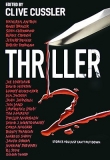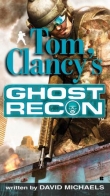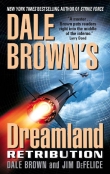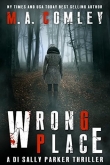
Текст книги "Ghost Fleet: A Novel of the Next World War"
Автор книги: P. Singer
Соавторы: August Cole
Жанр:
Триллеры
сообщить о нарушении
Текущая страница: 30 (всего у книги 37 страниц)
Boneyard Flight, Pacific Ocean
U.S. Air Force colonel Roscoe Coltan ended the transmission and rechecked his position. The twelve-by-nineteen-inch glass-panel Garmin AeroScreen was bolted on shock mounts over the F-15C jet’s original flight instruments. He had rimmed the screen with duct tape for good measure, which showed the level of confidence he had in the technology. It was effective, but it still didn’t seem right, which basically captured just about everything so far in this mission.
Roscoe’s jet had been among the 256 F-15s and F-16s the U.S. Air Force had early-retired in 2014. The argument was that the fourth generation of fighter planes couldn’t keep up with twenty-first-century threats, but the real reason was that retiring the planes created an artificial fighter gap, which helped make the case for keeping the spending up on the F-35, the fifth-generation plane, whose cost had spiraled. The old but still flyable planes had spent the past years stored out in the dry Arizona air of Davis-Monthan Air Force Base, aka the Boneyard, the aircraft equivalent of the Ghost Fleet. Alongside some four thousand other retired planes dating back to World War II, Roscoe’s jet had been waiting its turn to be harvested for scrap metal and spare parts.
But now, the age of the planes in Boneyard Flight worked to their advantage. They were crude, but they could be trusted. First flown in the 1970s, the F-15s needed only rudimentary electronics to operate; they had less computing power than his grandson’s talking toy bear and were steered by about twenty million fewer lines of code than the F-35. Most important, the chips in their flight systems had been produced long before hardware hacking or even the Directorate itself had been conceived.
His fuel gauge showed he had about two hours of flight time left if he just nursed the plane along. Unfortunately, the dogfight he expected would shave his time aloft down to a fraction of that.
Boneyard Flight had taken off with two dozen desert-worn KC-135s that had also been pulled out of retirement. Those things were tougher than cockroaches. First flown back in the Eisenhower days, the 707 passenger-jet derivatives did not have a modern chip anywhere, unlike the new KC-46s, which had turned out to be missile magnets like all the other Chinese-chipped gear.
The plan was that another flight of old Stratotankers would be waiting to refuel them on the return leg. He looked down at the rippled sea surface. It was a profoundly deep azure dusted with white lines that reminded him of a light snow on tree branches back home in North Carolina. The tankers would be there, the intelligence briefer had promised, and if not, he said, the sea would contain only friendly ships they could ditch near.
After two wives and twenty-four years in the Air Force, Roscoe knew when he was being bullshitted. He also knew when not to care.
“Oscar, Roscoe. You picking up the same fleet data I am? Over,” said Roscoe.
“Roger that, Roscoe,” said Oscar, an F-16 pilot flying the other element of the escort. The pilot had gotten his call sign back when he was a new lieutenant, a way to put him in his place after he’d been hot-dogging it in flight school. “Sky is clear over Oahu, but the squids look like they are in for some major rain, over.”
“I’m thinking we need to give them an umbrella. I’ll take Eagle and Wall-E elements of the escort to mix it up. You take Viper element on with the big boys to keep ’em safe and give the ground pounders some support, over.”
“Understood, Roscoe. Just like an Eagle driver to steal all the glory,” Oscar responded. “We’ll get them through. Good hunting, over.”
“Eagle Flight, I know you heard that conversation. Form up on me.” Then he paused, and when he spoke again, he made sure to enunciate his words. They said the voice-recognition software would work anyway, but he wanted to be certain.
“Wall-E Flight. Authorization Roscoe. Voice authenticate eagle, two, eight, alpha, delta. New mission order. Autonomous hunt. Air-to-air weapons authority release. Execute.”
He turned his head to see if they would follow the order or just start shooting down all the American jets close to them, like some bad movie. But the twelve F-40A Shrikes in the escort all took a smooth, literally perfect turn with a precision that would make a flight instructor orgasm and then formed up on the flanks of Eagle Flight’s F-15 fighters.
To Roscoe, it was one of the war’s many ironies that the jets they most needed to come through today were the very ones his service’s leadership had done its best to fight for years. Unmanned planes had proved their worth in the Afghan war and then in the various counterterrorism campaigns from Pakistan to Nigeria. But the early models had been remotely operated by pilots on the ground, and they were propeller-powered by four-cylinder engines taken from snowmobiles, meaning they had performance capabilities that even a World War I pilot would laugh at. The generals had always made sure to tell the public that while they were fine for killing terrorists, the early drones wouldn’t be able to survive in any kind of denied airspace. That was true enough, but oddly, behind the scenes, the critics did everything possible to make sure future models would have those very same flaws. The Pentagon, which had begrudgingly started using armed unmanned aerial systems after the CIA got into the business, consistently slow-rolled any attempts to make the next generation of drones faster, stealthier, and more lethal.
In the lean years after the Afghan war, the research budget for unmanned systems was slashed four times as much as any other program. The rationales for opposition included everything from worries about pilots losing jobs to defense contractors’ concerns that the better the new technology became, the more it would threaten their already signed multitrillion-dollar weapons contracts. It got to the point that, in 2013, when a test drone successfully took off and landed on an aircraft carrier by itself, the Naval Air Systems Command tried to send the cutting-edge technology not out to the fleet, but to the Smithsonian. There, in a museum, one of the most advanced planes on the planet could be “celebrated,” and, more important, it wouldn’t be carrying out any further tests that might make people rethink the existing order of things.
The F-40 Shrike program had been proposed by a maverick colonel who’d risked his career by publishing an article about it in the U.S. Air Force’s professional journal. He argued that instead of replacing its workhorse F-16 Fighting Falcon jets with the heavy and expensive F-35s, the Air Force should go with a similarly lightweight, cheap, and durable plane. The only difference was that it would be unmanned. It would get a small radar signature from having a thin, tailless, bat-wing shape that the absence of a cockpit made possible. Its software would match capabilities that had already been proven effective in the civilian market, autonomous flight and navigation, with weapons software that would follow the same identification-friend-or-foe protocols as missiles.
While the idea was anathema to leadership at the time, the concept of a cheap, useful combat drone struck a chord with the researchers at DARPA. A prototype was funded and it flew right about when Roscoe was starting his second marriage. But just like what had happened to the Predator drone a generation before, the little Shrike languished in what was known in the Beltway as the valley of death, never rising to full program status with the Air Force or the major contractors.
The program had received new life when all the agency’s old prototypes were reevaluated for their utility in a new war. There, the DARPA connection proved critical again, as the Shrike’s computer chips had been made through the agency’s trusted-foundry program, not sourced from the marked-up Chinese-made chips that the major contractors’ weapons programs used. Initially, the old guard in the Air Force had wanted to strip out the chips and use them as part of a plan to ramp up production of the very same manned planes that had failed at the war’s opening. But when Secretary of Defense Claiburne fired the air combat command general who had proposed it and said she would use Navy planes exclusively for future missions if anyone came to her with any more such backward-looking ideas, the rest of the service got onboard. It wasn’t only because of that proposal that the general was fired; Claiburne had already been planning to fire him, but she had held back until she could do it in what she called “a teachable moment.”
“Roscoe, one last thing,” Oscar called over as he watched the drones form up beside the old F-15s. “You better shoot down more bogeys than those damn robots do, or you and I are truly going to be out of the business.”
Pua’ena Point Beach Park, Hawaii Special Administrative Zone
Standing on the concrete slab that had been the foundation of the old radio tower, General Adams admired the controlled chaos. The last time this field had seen such a buzz of activity had been the original “day of infamy” itself.
Back in 1941, the Haleiwa fighter strip had been a satellite landing field away from the main U.S. Army Air Corps base at Wheeler airfield. As soon as the attack started, without waiting for orders, two young fighter pilots, Lieutenants George Welch and Kenneth Taylor, had jumped in a car and raced to the secondary field. They made the twisting sixteen-mile drive in under fifteen minutes. When they arrived, the crew chiefs told them that instead of flying out, they should disperse the aircraft on the ground. “The hell with that,” said Welch.
Ignoring the usual pre-takeoff checklists, each pilot climbed into a P-40 Warhawk fighter plane and took off down the airstrip. Only once they were in the air did they figure out they were about to take on over three hundred enemy aircraft. Undeterred, Welch and Taylor plowed straight into the second wave of the Japanese attack. They didn’t stop the attack, but they did manage to shoot down six planes before they ran out of ammunition. More important, the two pilots put up enough of a fight that Japanese planners assumed there were far more defenders in the air. They decided against sending in a final, third attack wave designed to pummel Pearl Harbor’s fuel storage, maintenance, and dry-dock repair yards, an attack that would have set back the American war effort at least another year.
The airstrip stayed in use up to the 1960s and was then turned over to the locals. Eventually owned by Kamehameha Schools and renamed Pua’ena Point, the real estate remained undeveloped, the concrete tarmac becoming cracked and gradually overtaken by the jungle. The only human presence for the past decades had been a squatters’ camp and an occasional rave party.
This real estate was now priceless to Adams. All the other active airstrips on the island, even the small civilian fields, had been used by the Directorate for basing and drone-landing strips, and they’d been taken out by the Z’s bombardment. A platoon of his Marines had been tasked to prep the old field as best they could, clearing away the squatter shacks, bushes, and concrete fragments that blocked the field. When word of what they were doing spread, civilians had started showing up to help. Retirees with garden tools, surfers with their bare hands, the now truly homeless squatters, all filling in holes in the tarmac and hacking away at the jungle. That had been unexpected good fortune. A corporal was now directing eighty of them in the cleanup of a helicopter-landing site, over where the hangars used to be. That would mean Adams could keep the runway clear and still bring his attack helicopters off the ships ahead of schedule. Even better, a SEAL fire team had appeared out of the jungle with two bulldozers and a Polish navy officer driving a massive yellow roller. He couldn’t even begin to fathom where they had found construction equipment in the middle of a battle, but he’d take it.
“Sir, they’re here,” his aide Lieutenant Jacobsen said.
“Dank you, ’Tenant,” Adams responded, his jaw still numb. “Clear um ut.”
Jacobsen ordered those still on the runway to clear as an F-16 buzzed low and waggled its wings. Typical pilot hot-dog bullshit, thought Adams. Despite all the work, the runway was still far too rough for any plane to land on. He forgave the pilot as the F-16 flew on toward the front, where it could do some actual good.
What Adams cared most about were the big lumbering planes that were appearing in the sky, the massive C-5 Galaxies that could carry over two hundred and seventy thousand pounds of payload, the sleek C-141 Starlifters that had ferried troops to Vietnam and the First Gulf War, and even some of the more modern C-17 Globemasters. He knew they were the early production models, built before the full reliance on electronics.
Three missiles arced up toward the planes from the east, somewhere behind enemy lines. The spray of countermeasure flares distracted one missile, but the other two smashed into a C-5 and sent it careening into the ocean. Adams could see the F-16s in the escort, 20 mm Vulcan cannon firing, swoop down to punish whoever had committed the transgression of harming their flock.
Undeterred, the other big planes moved closer, the first wave filling the air with tiny dots that blossomed into parachutes, each C-141 dumping a string of 123 paratroopers as it flew overhead.
As they landed on the airfield, Adams blessed those civilians yet again. Every filled pothole in the tarmac meant one less twisted ankle or sprained knee taking a soldier out of action. Marines ran out to help the paratroopers stow their parachutes and find their rally points.
At each unit rally point, a line of civilian vehicles waited on the road leading out to the main town. Just as World War I French troops had been ferried to the Battle of the Marne in Parisian buses, the Third Brigade Combat Team of the Eighty-Second Airborne Division would join the Battle of Kamehameha Highway in a mix of pickup trucks, SUVs, and even a few minibuses from the local tour companies.
The next wave of cargo planes came down low, almost at sea level, staggered out in a long line, one behind another. As each plane raced down the length of the runway with its rear door open, a drogue parachute deployed out the back, caught the air, and then yanked out a large pallet. The plane then pulled up, its wheels never having touched the ground, and the pallet slid and bumped down the runway at over a hundred miles per hour before friction caused it to grind slowly to a stop. Teams of civilians directed by a paratrooper then swarmed over the pallet, tearing at thick belts strapping down everything from aviation-fuel bladders to combat vehicles. With all that extra manpower, the offloading went at least twice as fast as anticipated, and it freed up more forces for the frontlines. Adams heard Jacobsen yelling at the workers to prioritize the M1128 Stryker mobile-gun systems. Damn, that boy was good. The eight-wheeled armored fighting vehicles each mounted a 105 mm tank gun, which meant Adams could soon start punching back, hard.
The most lethal supplies to come in on the pallets, though, were what looked like two ordinary fuel-tank trucks. In fact, the tanks were filled not with fuel but with a mix of resin-based binders. When sprayed down and smoothed out over the base of the old runway, the substance would form polyurethane polymer concrete. After just thirty minutes of drying time, he would own the only operative airfield on the island.
Adams smiled at the thought, the first smile he’d allowed himself in months. It quickly died, though, when Jacobsen reached over with a handkerchief to dab away a thin trickle of drool dripping from the corner of the general’s still-numb mouth.
Boneyard Flight, Pacific Ocean
Roscoe fired a pair of AIM-120E AMRAAM air-to-air missiles well before he could see the enemy planes. The twelve-foot-long missiles came cleanly off his plane’s fuselage stations and disappeared into the blue sky ahead. With so much radar and communications interference, these were the long shots. Shoot two, hope maybe to hit one. More usefully, they’d create a cover of fast-moving death for his jets to come in behind, throwing off whatever formation the enemy had planned.
He pushed the plane to afterburners, noticing a faint vibration in his ejection seat as his F-15C’s speed passed Mach 2. With no stealth features, the older planes would be at a disadvantage until they made this an up-close-and-personal knife fight. Plus the F-15C’s speed meant they could start their kill count before the slower Shrike drones arrived.
It all happened in seconds: a few explosions in the distance and alongside him as others in Eagle Flight were hit by the enemy’s counterfire, and then a swirl of smoke and contrails as fighters from three nations mixed it up.
Roscoe could focus only on his part of the fight, quickly firing a pair of AIM-9X Sidewinder missiles at two Russian MiG-35s less than a mile away, both of them banking hard as they tried to get inside the turn circle of another F-15. One missile went astray but the second smashed into the trailing jet’s tail section with an explosion that pitched the MiG’s nose skyward and then left a smoky scar in the sky. The other MiG fighter jet turned to escape, Roscoe following. As he turned, a faint puff of tracer rounds crossed in front of him; a Chinese J-31 fighter was boring through the chaos, its nose trained on Roscoe’s F-15. Before Roscoe could evade, one of the incoming rounds blew off the top of his left vertical stabilizer.
The F-15 shuddered and buffeted as the J-31 bird-dogged Roscoe, staying on his rear. Instinctively, the experienced pilot unloaded the jet. While one way to gain speed was to max engine power, the most effective way was essentially to trick physics into working for you. Roscoe slid the stick forward and put the aircraft into a shallow ten-degree dive. As the plane dipped slightly, it created a zero-g condition, essentially “unloading” weight from the plane, akin to going over the crest of a small hill in a bicycle and coming out of your seat. Acceleration is a matter of thrust and weight, and in that weightless moment, Roscoe’s F-15 powered ahead rapidly, leaving his attacker behind.
As Roscoe saw the airspeed indicator approaching Vmax, the highest speed possible within the structural design limits of the plane, he felt a sharp shudder, the damaged tail wing starting to crack. The engineers who had set the plane’s Vmax hadn’t counted on the effect of a 30 mm cannon. As Roscoe pulled the stick up to lose speed, his radar-warning receiver howled: the J-31 was catching up to finish him off.
He pushed the throttles all the way forward, rolled the plane onto its back, and pulled the stick back into the seat pan. He hoped that the Directorate pilot would get greedy, cut across his turn circle, and provide him a reversal opportunity. It was a classic move, which, unfortunately, meant it was one the J-31 pilot had been trained to counter. Roscoe snuck a look over his shoulder and saw the Directorate plane stabilized at his deep six o’clock, between his tail.
Roscoe swung the plane back and forth, straining against the force of the turns, trying to ruin the J-31’s firing solution but knowing his bag of tricks was empty. His plane groaned with the turns. If a Chinese missile didn’t kill him, his jet would.
His flight suit compressed and fought the g-forces just as Roscoe pulled into another tight turn. The tunnel vision started, the perimeter of his field of vision beginning to shade inward from the massive pressure on his body. A gray form entered on the right side of his line of sight, just above his canopy, and then disappeared as the tunnel around him grew smaller and smaller. He was blacking out; he knew it.
Roscoe pulled out of the turn; the tunnel widened, and the heavy weight on his body lifted. His plane’s radar-warning receiver abruptly went silent. He craned his neck to see where the J-31 was. He couldn’t find it at first, and then he saw the matte-gray-and-blue Chinese fighter falling end over end toward the ocean below, trailing a thick plume of smoke and flame. Flying away was a Shrike. The wedge-shaped drone pulled an insanely tight turn that would have knocked out any human pilot, firing a missile at a MiG-35 in the midst of it. Even before that MiG exploded, the Shrike was already off hunting its next target, its autonomous programming relentless in its computerized efficiency.
“Little bastard didn’t even stop to see if I was okay,” said Roscoe, silently thanking the drone’s designers.
He checked his radar display, which was momentarily free of jamming strobes. He felt sick when he saw how empty the sky was of aircraft. In less than a minute, at least a hundred lives had been lost.
“Longboard, Longboard, this is Boneyard Leader. We’ve serviced most of your visitors, but I show eight leakers made it through our picket line. MiG-35s,” he said, trying to steady his voice as his plane bucked. “We’re going to run them down, but it looks like some bogeys are going to make it to you first, over.”
The four F-15s remaining in Eagle Flight took off in pursuit at almost nine hundred miles an hour, their maximum at low altitude. The low-fuel warning flashed in Roscoe’s cockpit. Going to afterburner so much would cost him the chance to get home, he thought, but that was beside the point at this stage of the game.
He visually picked up the Russian MiGs by the telltale signs of their missile launches. The remains of Eagle Flight had arrived too late.
“Jesus, that’s a lot of hurt,” said Roscoe to the other three pilots. “I count at least two dozen missiles.”
“At least thirty,” said Squiggle, the pilot in the F-15C flying off Roscoe’s right wing.
“Fire everything you have left. Use ’em or lose ’em!” Roscoe ordered.
He fired off his remaining AIM-9X, visually following it as it locked on one of the MiGs trailing the formation. The MiG was breaking upward, climbing for more altitude after launching its anti-ship missiles, when the Sidewinder exploded just aft of the jet.
“Eagle Flight, I’m Winchester,” Roscoe said, letting whoever was left know he was down to guns only.
He pushed his jet past the MiG flat-spinning into the waves below, maxing the power to try to run down the cruise missiles starting to accelerate into the distance. Above him, the Russian and American jets grappled in a final violent confrontation that took six Russian missiles and two more MiGs out of the sky but also resulted in the destruction of three of the four American F-15s.
He’d hoped to catch one of the missiles with a lucky shot from his guns, but his luck had run out; the F-15’s damaged vertical stabilizer broke away like a shingle in a hurricane. “So there’s me,” said Roscoe to himself as he struggled with the bucking plane.
He eyed the ocean below, looking for the driest spot to ditch in. The left engine began to sputter. His war would end now. Roscoe took his left hand off the stick and reached for the yellow metal bar by his knee on which his crew chief had jokingly written Do not touch! in felt-tip marker. The plane’s violent pitching made getting a grip on the ejection handle far harder than he’d expected.

![Книга [Magazine 1966-07] - The Ghost Riders Affair автора Harry Whittington](http://itexts.net/files/books/110/oblozhka-knigi-magazine-1966-07-the-ghost-riders-affair-199012.jpg)






